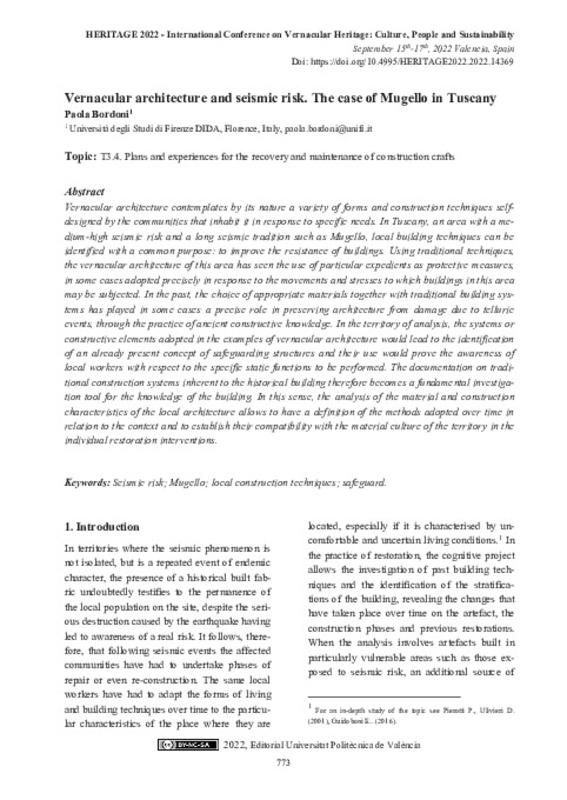JavaScript is disabled for your browser. Some features of this site may not work without it.
Buscar en RiuNet
Listar
Mi cuenta
Estadísticas
Ayuda RiuNet
Admin. UPV
Vernacular architecture and seismic risk. The case of Mugello in Tuscany
Mostrar el registro sencillo del ítem
Ficheros en el ítem
| dc.contributor.author | Bordoni, Paola
|
es_ES |
| dc.coverage.spatial | east=11.399986; north=43.9500264; name=Mugello, Borgo San Lorenzo FI, Itàlia | es_ES |
| dc.date.accessioned | 2022-11-07T13:45:18Z | |
| dc.date.available | 2022-11-07T13:45:18Z | |
| dc.date.issued | 2022-09-13 | |
| dc.identifier.isbn | 9788413960203 | |
| dc.identifier.uri | http://hdl.handle.net/10251/189291 | |
| dc.description.abstract | [EN] Vernacular architecture contemplates by its nature a variety of forms and construction techniques self- designed by the communities that inhabit it in response to specific needs. In Tuscany, an area with a me- dium-high seismic risk and a long seismic tradition such as Mugello, local building techniques can be identified with a common purpose: to improve the resistance of buildings. Using traditional techniques, the vernacular architecture of this area has seen the use of particular expedients as protective measures, in some cases adopted precisely in response to the movements and stresses to which buildings in this area may be subjected. In the past, the choice of appropriate materials together with traditional building sys- tems has played in some cases a precise role in preserving architecture from damage due to telluric events, through the practice of ancient constructive knowledge. In the territory of analysis, the systems or constructive elements adopted in the examples of vernacular architecture would lead to the identification of an already present concept of safeguarding structures and their use would prove the awareness of local workers with respect to the specific static functions to be performed. The documentation on tradi- tional construction systems inherent to the historical building therefore becomes a fundamental investiga- tion tool for the knowledge of the building. In this sense, the analysis of the material and construction characteristics of the local architecture allows to have a definition of the methods adopted over time in relation to the context and to establish their compatibility with the material culture of the territory in the individual restoration interventions. | es_ES |
| dc.format.extent | 8 | es_ES |
| dc.language | Inglés | es_ES |
| dc.publisher | Editorial Universitat Politècnica de València | es_ES |
| dc.relation.ispartof | Proceedings HERITAGE 2022 - International Conference on Vernacular Heritage: Culture, People and Sustainability | |
| dc.rights | Reconocimiento - No comercial - Compartir igual (by-nc-sa) | es_ES |
| dc.subject | Seismic risk | es_ES |
| dc.subject | Mugello | es_ES |
| dc.subject | Local construction techniques | es_ES |
| dc.subject | Safeguard | es_ES |
| dc.title | Vernacular architecture and seismic risk. The case of Mugello in Tuscany | es_ES |
| dc.type | Capítulo de libro | es_ES |
| dc.type | Comunicación en congreso | es_ES |
| dc.identifier.doi | 10.4995/HERITAGE2022.2022.14369 | |
| dc.rights.accessRights | Abierto | es_ES |
| dc.description.bibliographicCitation | Bordoni, P. (2022). Vernacular architecture and seismic risk. The case of Mugello in Tuscany. En Proceedings HERITAGE 2022 - International Conference on Vernacular Heritage: Culture, People and Sustainability. Editorial Universitat Politècnica de València. 773-780. https://doi.org/10.4995/HERITAGE2022.2022.14369 | es_ES |
| dc.description.accrualMethod | OCS | es_ES |
| dc.relation.conferencename | HERITAGE2022 International Conference on Vernacular Heritage: Culture, People and Sustainability | es_ES |
| dc.relation.conferencedate | Septiembre 15-17, 2022 | es_ES |
| dc.relation.conferenceplace | Valencia, España | es_ES |
| dc.relation.publisherversion | http://ocs.editorial.upv.es/index.php/HERITAGE/HERITAGE2022/paper/view/14369 | es_ES |
| dc.description.upvformatpinicio | 773 | es_ES |
| dc.description.upvformatpfin | 780 | es_ES |
| dc.type.version | info:eu-repo/semantics/publishedVersion | es_ES |
| dc.relation.pasarela | OCS\14369 | es_ES |








